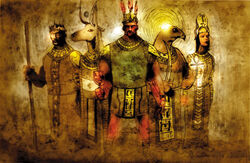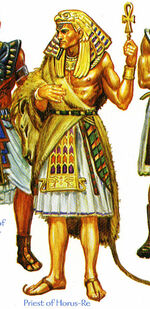Horus-Re (pronounced: /ˈhɔːrʌsˈreɪ/ HOR-us-RAY[7]) was the leader of the Mulhorandi pantheon. Known by the name Helcaliant in Thay and that of Hokatep in Unther, he was an honorable deity that opposed change.[1]
History
Horus was originally a young deity that often sided with Anhur in pressing change to his father, Re.[1]
When Re was defeated by Gruumsh during the Orcgate Wars, the failing deity passed his powers and domain to Horus before passing on. Upon gaining this power Horus became Horus-Re, and began exhibiting the personality traits and beliefs of his dead father.[1]
During the Second Sundering, Horus returned as a separate entity from Re along with other deities from the pantheon in the form of demigods and led the Mulhorandi uprising against the Imaskari, in a manner similar to how the Chosen manifested in other regions. As of 1489 DR, Mulhorand was led by the returned pantheon, who temporarily set their differences aside for the good of the Mulhorandi people.[3]
Relationships
Horus-Re's allies included Isis, Osiris, and Thoth, though all the Mulhorandi pantheon accepted his commands. Lathander also saw Horus-Re in a favorable light.[7]
Horus-Re's opposition to change often brought him into conflict with Anhur,[1] and he did all he could to thwart the actions of Set.[6]
Avatar

Horus-Re usually appeared as a Mulan human possessing the head of a hawk. He rode the airborne galley Matet (or Semktet) and carried a glowing ankh.[6]
Powers and abilities
Horus-Re was able to project a ray of damaging light from his eye. His ankh had the ability to destroy undead, and he wielded the Sword of Horus in battle.[6]
Other manifestations
The will of Horus-Re could be communicated through the actions of animals such as hawks or creatures such as solars and lammasu.[6]
- Celestial events
- The sun represented Horus-Re in the day, and a shooting star signified his presence at night. The sky darkened if a follower failed to carry out the will of the Lord of the Sun, and it was said the sun would go dark if Set usurped Horus-Re's position.[6]
- Sound
- The cry of a hawk signified the fitting punishment of a criminal, and a thunder clap was a sign of Horus-Re's favor.[6]
- Animals
- The eye of Horus-Re was often signified by a circling hawk.[6]
Church of Horus-Re

The position of priest in the church of Horus-Re was hereditary; members belonged to the House of Helcaliant, and could claim at least one divine incarnation of Horus-Re among their ancestors. The church of the Lord of the Sun was the leading political body in Mulhorand; it was led by the pharaoh, Horustep III, and the vizier Kalarzim.[6]
The clergy of the church of Horus-Re traditionally spent its time serving in government positions, but were slowly turning their attention to spreading the worship of their deity.[9]
Priests of Horus-Re were usually nobles. They tended to be arrogant and expected to receive special treatment from those with lesser standing, and were often motivated by political gain as much as divine calling.[6]
Temples dedicated to Horus-Re often served in an official government capacity, in addition to being a center of worship. All such structures stressed openness and justice in their construction. The primary temple and center of the church of Horus-Re, the Solarium of Skuld, was located in the capital city of Skuld.[9]
The Church of Horus-Re began expanding into Unther in the wake of the Time of Troubles.[9]
Worshipers
Worship of Horus-Re was most likely among nobles and the elite of Mulhorandi society. Most individuals serving in a government position considered themselves a follower of the Pharaoh of the Gods.[6]
Clerics of Horus-Re typically wore white linen skirts and sandals. Some wore wigs over shaved heads, topped by a headdress. Like all priests of Mulhorand, they painted three circles on their forehead to symbolize their divine calling. They might don false beards for official occasions.[9]
When the clergy of Horus-Re prepared for combat, they selected equipment practical to the situation. They preferred light armor, and always wore some form of headdress.[9]
Clerics of Horus-Re prayed for spells as part of the Zenith Aspirant, when the sun was at its highest point in the sky.[7]
Affiliated orders
The church of Horus-Re served as the government of Mulhorand.[6]
- Claws of the Sun and the Ankh
- This organization was composed of paladins of Horus-Re, who devoted themselves to their divine responsibilities rather than the politics of the nation.[9]
Celebrations and festivals
The followers of Horus-Re performed three celebrations daily.[9]
- Greeting of the Lord
- Each morning, the faithful of Horus-Re celebrated the rising sun.[9]
- Zenith Aspirant
- The clergy of Horus-Re performed a daily sermon when the sun was at its highest point.[9]
- Girding of the Guard
- The clergy of Horus-Re took up weapons every evening to defend their nation throughout the night.[9]
- Midsummer's Day
- Priests of Horus-Re spent the day praising the Lord of the Sun. The government of Mulhorand was shut down during this time.[9]
- Solar Eclipse
- A solar eclipse signified Horus-Re's right to rule. Priests of the Master of Vengeance sought to thwart the servants of Set on such days.[9]
Appendix
Gallery
References
- ↑ 1.00 1.01 1.02 1.03 1.04 1.05 1.06 1.07 1.08 1.09 1.10 Eric L. Boyd (September 1997). Powers & Pantheons. Edited by Julia Martin. (TSR, Inc.), p. 109. ISBN 978-0786906574.
- ↑ 2.0 2.1 2.2 2.3 2.4 Eric L. Boyd, Erik Mona (May 2002). Faiths and Pantheons. Edited by Gwendolyn F.M. Kestrel, et al. (Wizards of the Coast), p. 143. ISBN 0-7869-2759-3.
- ↑ 3.0 3.1 Steve Kenson, et al. (November 2015). Sword Coast Adventurer's Guide. Edited by Kim Mohan. (Wizards of the Coast), p. 41. ISBN 978-0-7869-6580-9.
- ↑ Hal Maclean (September 2004). “Seven Deadly Domains”. In Matthew Sernett ed. Dragon #323 (Paizo Publishing, LLC), p. 65.
- ↑ Richard Baker, James Wyatt (March 2004). Player's Guide to Faerûn. (Wizards of the Coast), p. 189. ISBN 0-7869-3134-5.
- ↑ 6.00 6.01 6.02 6.03 6.04 6.05 6.06 6.07 6.08 6.09 6.10 6.11 Eric L. Boyd (September 1997). Powers & Pantheons. Edited by Julia Martin. (TSR, Inc.), p. 111. ISBN 978-0786906574.
- ↑ 7.0 7.1 7.2 Eric L. Boyd, Erik Mona (May 2002). Faiths and Pantheons. Edited by Gwendolyn F.M. Kestrel, et al. (Wizards of the Coast), p. 144. ISBN 0-7869-2759-3.
- ↑ Eric L. Boyd (September 1997). Powers & Pantheons. Edited by Julia Martin. (TSR, Inc.), p. 11. ISBN 978-0786906574.
- ↑ 9.00 9.01 9.02 9.03 9.04 9.05 9.06 9.07 9.08 9.09 9.10 9.11 Eric L. Boyd (September 1997). Powers & Pantheons. Edited by Julia Martin. (TSR, Inc.), p. 112. ISBN 978-0786906574.
- ↑ Eric L. Boyd (September 1997). Powers & Pantheons. Edited by Julia Martin. (TSR, Inc.), p. 110. ISBN 978-0786906574.
Connections
Faerûnian Pantheon
Akadi | Amaunator | Asmodeus | Auril | Azuth | Bane | Beshaba | Bhaal | Chauntea | Cyric | Deneir | Eldath | Gond | Grumbar | Gwaeron | Helm | Hoar | Ilmater | Istishia | Jergal | Kelemvor | Kossuth | Lathander | Leira | Lliira | Loviatar | Malar | Mask | Mielikki | Milil | Myrkul | Mystra | Oghma | Red Knight | Savras | Selûne | Shar | Silvanus | Sune | Talona | Talos | Tempus | Torm | Tymora | Tyr | Umberlee | Valkur | Waukeen
The Morndinsamman
Abbathor | Berronar Truesilver | Clangeddin Silverbeard | Deep Duerra | Dugmaren Brightmantle | Dumathoin | Gorm Gulthyn | Haela Brightaxe | Laduguer | Marthammor Duin | Moradin | Sharindlar | Vergadain
The Seldarine
Aerdrie Faenya | Angharradh | Corellon | Deep Sashelas | Erevan | Fenmarel Mestarine | Hanali Celanil | Labelas Enoreth | Rillifane Rallathil | Sehanine Moonbow | Shevarash | Solonor Thelandira
The Dark Seldarine
Eilistraee | Kiaransalee | Lolth | Selvetarm | Vhaeraun
Yondalla's Children
Arvoreen | Brandobaris | Cyrrollalee | Sheela Peryroyl | Urogalan | Yondalla
Lords of the Golden Hills
Baervan Wildwanderer | Baravar Cloakshadow | Callarduran Smoothhands | Flandal Steelskin | Gaerdal Ironhand | Garl Glittergold | Nebelun | Segojan Earthcaller | Urdlen
Orc Pantheon
Bahgtru | Gruumsh | Ilneval | Luthic | Shargaas | Yurtrus
Mulhorandi pantheon
Anhur | Bast | Geb | Hathor | Horus | Isis | Nephthys | Osiris | Re | Sebek | Set | Thoth
Other gods of Faerûn
Bahamut | Enlil | Finder Wyvernspur | Ghaunadaur | Gilgeam | Lurue | Moander | Nobanion | Raven Queen | Tiamat
Greater Gods of Faerûn
Amaunator | Asmodeus | Bane | Chauntea | Corellon | Cyric | Ghaunadaur | Gruumsh | Kelemvor | Lolth | Moradin | Oghma | Selûne | Shar | Silvanus | Sune | Tempus | Torm
Gods of Faerûn
Angharradh | Auril | Bahamut | Berronar Truesilver | Beshaba | Garl Glittergold | Gond | Ilmater | Loviatar | Luthic | Malar | Mielikki | Sheela Peryroyl | Sseth | Talona | Tiamat | Tymora | Umberlee | Waukeen | Zehir
Exarchs of Faerûn
Abbathor | Arvoreen | Baervan Wildwanderer | Bahgtru | Baravar Cloakshadow | Brandobaris | Callarduran Smoothhands | Clangeddin Silverbeard | Cyrrollalee | Deep Sashelas | Dugmaren Brightmantle | Erevan Ilesere | Fenmarel Mestarine | Fzoul Chembryl | Garagos | Hoar | Hruggek | Jergal | Labelas Enoreth | Lliira | Maglubiyet | Malar | Marthammor Duin | Milil | Obould | Red Knight | Sharess | Shargaas | Shevarash | Shiallia | Siamorphe | Solonor Thelandira | Thard Harr | Uthgar | Valkur | Vaprak | Vergadain
Greater Deities of Faerûn
Angharradh | Bane | Chauntea | Corellon Larethian | Cyric | Garl Glittergold | Gruumsh | Horus-Re | Kelemvor | Lathander | Moradin | Mystra | Oghma | Shar | Silvanus | Sune | Talos | Tempus | Tyr | Yondalla
Intermediate Deities of Faerûn
Abbathor | Arvoreen | Baervan Wildwanderer | Berronar Truesilver | Beshaba | Callarduran Smoothhands | Clangeddin Silverbeard | Cyrrollalee | Deep Duerra | Deep Sashelas | Dumathoin | Erevan Ilesere | Flandal Steelskin | Gond | Hanali Celanil | Helm | Ilmater | Isis | Labelas Enoreth | Laduguer | Lolth | Mask | Mielikki | Nephthys | Osiris | Rillifane Rallathil | Sehanine Moonbow | Segojan Earthcaller | Selûne | Set | Sharindlar | Sheela Peryroyl | Solonor Thelandira | Thoth | Tymora | Umberlee | Urdlen | Vergadain
Major Deities of Faerûn
Angharradh | Bane | Bhaal | Chauntea | Corellon Larethian | Garl Glittergold | Gruumsh | Horus-Re | Lathander | Moradin | Myrkul | Mystra | Oghma | Shar | Silvanus | Sune | Talos | Tempus | Tyr | Yondalla
Other Deities of Faerûn
Auppenser | Abbathor | Arvoreen | Auril | Baervan Wildwanderer | Berronar Truesilver | Beshaba | Callarduran Smoothhands | Clangeddin Silverbeard | Cyrrollalee | Deep Duerra | Deep Sashelas | Dumathoin | Erevan Ilesere | Flandal Steelskin | Gond | Hanali Celanil | Helm | Ilmater | Isis | Labelas Enoreth | Laduguer | Lolth | Mask | Mielikki | Nephthys | Osiris | Rillifane Rallathil | Sehanine Moonbow | Segojan Earthcaller | Selûne | Set | Sharindlar | Sheela Peryroyl | Solonor Thelandira | Thoth | Tymora | Umberlee | Urdlen | Vergadain

![Resurrection of Osiris.jpg (113 KB) Resurrection of Osiris.[10]](https://static.wikia.nocookie.net/forgottenrealms/images/f/f9/Resurrection_of_Osiris.jpg/revision/latest/scale-to-width-down/162?cb=20070903193607)